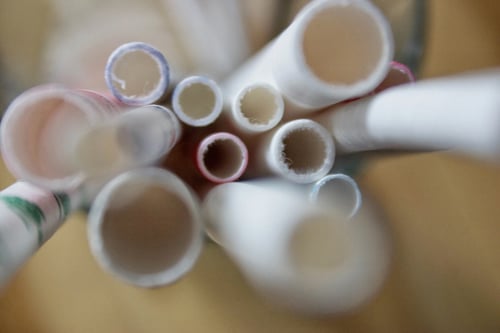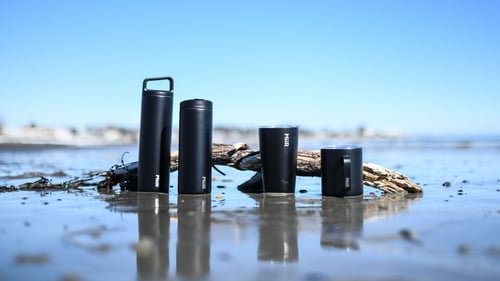An ode to the humble t-shirt
Quick. Think about your favorite t-shirt. You know, the one you can’t wait to throw on after a long day.
Why do you reach for it over and over again? Why are some of your t-shirts relegated to thrift store bins while others maintain holy grail status in your special t-shirt drawer?
We wear what we love.
And, boy, do we love our t-shirts. A staple of the collective world wardrobe, a t-shirt feels honest and unpretentious. Worn in. And worn out. You can count on it every day to be there for you, come rain, shine or “lordy, I need to do some laundry.”
A beloved t-shirt is a slice of your identity and shows the world what you care about. And what you love.
Yes, a favorite t-shirt is a thing of beauty.
But...
It wasn’t always this way.
AN EXTREMELY BRIEF HISTORY OF THE T-SHIRT
Let’s nerd out for a sec and dive into some weird history. You’ve gotta know where you came from to know where you’re going, right?
The t-shirt began its winding journey in the late 1800s as one-piece long underwear. Think adult onesie. Or Pa Ingalls getting into bed at night. It was about as far as you could get from today’s soft, cozy tees. The problematic one-piecer was eventually cut in half to keep people cooler while working in the warmer months.
The t-shirt as we know it today was officially invented in 1902 as a lightweight undergarment for men. The US Navy began issuing these undershirts to sailors to be worn under their uniforms. And then Hollywood came along. T-shirts became mainstream when movie icons such as Marlon Brando and James Dean popularized wear-alone t-shirts (and ushered in an era of provocative rebellion).
In the 60s and 70s, t-shirts with logos, slogans and graphics became a form of self-expression, a representation of one’s opinion on different social movements and causes. Its wearability and accessibility transformed the fashion world and forever changed the way messages are shared.
T-shirts continue to evolve, with extended sizes, colors, fabrics and decoration techniques. We’ve come a long way since the plain white tee.
WHAT MAKES A T-SHIRT GREAT?
Fun fact:
47% of consumers keep a promotional t-shirt for two years or longer. The average t-shirt gets over 100 wears (or 3000+ impressions) over its lifetime. (Source: ASI Central)
Pretty cool. Three-thousand impressions are nothing to sniff at. But imagine what you could do with a t-shirt that went beyond “average!”
We have a few thoughts about what makes a t-shirt great:
- Ultra soft = insanely comfortable = holy grail territory.
- No one likes tags. But if your branded t-shirt has a tag, make sure it’s not one of those scratchy, flippy, irritating flaps. Also, did you know that tagless t-shirts exist? Ah, t-shirts these days. Such overachievers.
- The general consensus is that using logos is cool if they are part of the overall design, but they shouldn’t be the main focus. Gone are the days of slapping a yawn-worthy 2” logo on the front left chest.
- For the love of Ted Lasso’s mustache, please make your graphics interesting. Trust us on this. Distinctive wins, every time. If the design process feels daunting, please reach out. We are overflowing with ideas.
HAVING ONLY ONE OPTION IS NOT AN OPTION
There are numerous ways to decorate a t-shirt. We once read a story about a diamond-studded tee. 16 diamonds. 9 total carats. Only $400,000.
(Plus, you get to freak out whenever you wear or wash it.)
Um, no thanks.
We’ll stick with some of our favorite ways to brand a t-shirt:
SCREENPRINTING
This is the OG of t-shirt printing methods. A stencil and mesh screen are used to “paint” your image onto the t-shirt. Each color requires a separate stencil. Screenprinting is durable and great for a larger run of the same print.
SUBLIMATION
Sublimation is perfect for big, complex designs such as full-color photographic prints or all-over graphics. The process uses transfer paper + heat + pressure to directly dye the fabric. (The dye on the paper converts from a solid into a gas and resolidifies into the fabric. #science) Sublimation works best on polyester fabrics.
DIRECT TO GARMENT (DTG)
DTG printing is similar to the way paper printers work. A special DTG machine prints the design directly onto the t-shirt. It’s good for complex artwork, especially if a smaller quantity is needed. DTG works on fabrics with a high cotton ratio.
HEAT TRANSFER
Ah, the cool cousin of sublimation. This method uses transfer paper, heat and pressure to thermally bond graphics onto the surface of the tee. The ink feels stiffer than sublimation because it doesn’t sink into the fabric. Heat transfer works well on various fabrics and is suitable for smaller quantities.
Other specialty decoration techniques we love include custom patches, vinyl transfers, flocking, glitter, suede, foil accents and rhinestones (no diamonds...sorry).
GET OUR COVETED PASSIONAUT T-SHIRT
The true test of great branded merch is if your crowd reaches for it over and over. So give them something they’ll keep forever.
Buzztag makes t-shirts easy. We have fresh ideas. We have years of experience.
And we have these rad Passionaut t-shirts we’re giving away when you reach out to schedule an “I never thought of that” discovery call with us. It’s as easy as clicking here.
Let’s start something!




